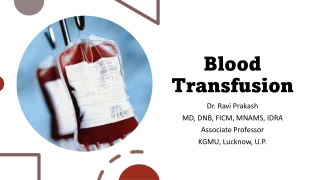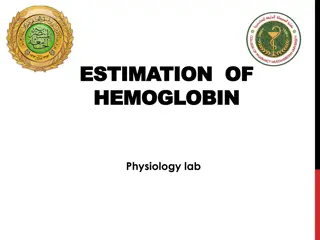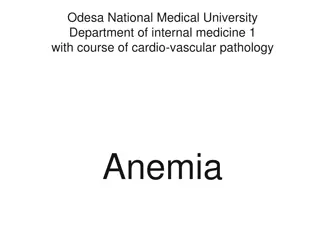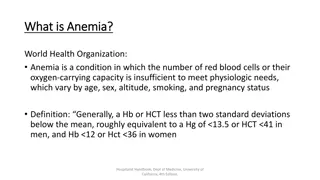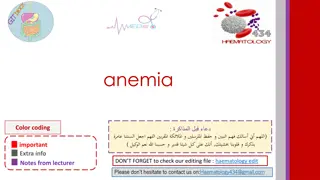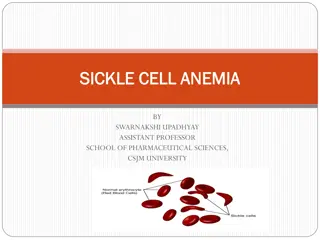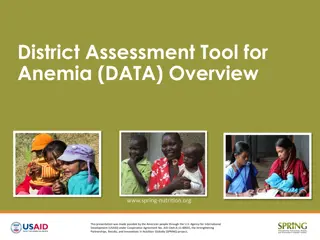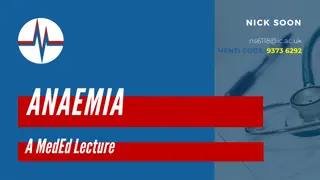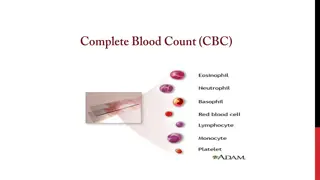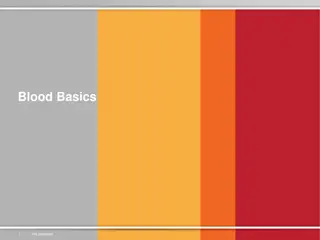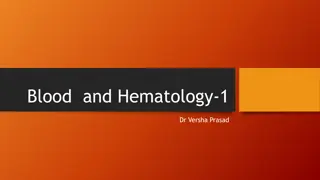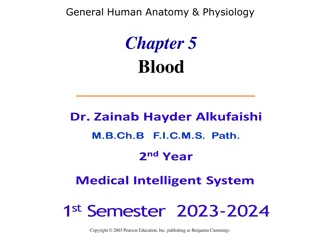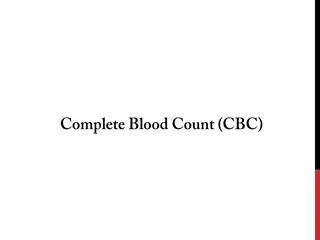Overview of Red Blood Cells and Anemia
Red blood cells, or erythrocytes, play a crucial role in oxygen transport, while anemia results from low red blood cell count or hemoglobin levels. Learn about the causes and classifications of anemia, including iron deficiency anemia. Understanding these concepts is essential for understanding blood disorders and their implications on overall health.
Download Presentation

Please find below an Image/Link to download the presentation.
The content on the website is provided AS IS for your information and personal use only. It may not be sold, licensed, or shared on other websites without obtaining consent from the author.If you encounter any issues during the download, it is possible that the publisher has removed the file from their server.
You are allowed to download the files provided on this website for personal or commercial use, subject to the condition that they are used lawfully. All files are the property of their respective owners.
The content on the website is provided AS IS for your information and personal use only. It may not be sold, licensed, or shared on other websites without obtaining consent from the author.
E N D
Presentation Transcript
Red blood cell, also called erythrocyte, component of blood, millions of which in the circulation of vertebrates characteristic colour and carry oxygen from the lungs to the tissues. The mature human red blood cell is small, round, and biconcave; it appears dumbbel- shaped in profile. The cell is flexible and assumes a bell shape as it passes through extremely small blood vessels. It is covered with a membrane composed of lipids and proteins, lacks a nucleus, and contains hemoglobin a red, iron-rich protein that binds cellular give the blood its oxygen
What is anemia: Anemia is a medical condition in which the red blood cell count or hemoglobin is less than normal. The normal level of hemoglobin is generally different in males and females. For men, anemia is typically defined as hemoglobin level of less than 13.5 gram/100ml and in women as hemoglobin of less than 12.0 gram/100ml. These definitions may vary slightly depending on the source and the laboratory reference used.
Anemia is caused essentially through two basic pathways. Anemia is either caused: 1 1-by a decrease in production of red blood cell or hemoglobin, or 2 2-by a loss or destruction of blood. As more common classifications of anemia (low hemoglobin) is based on the) MCV (mean corouscular volume, or the volume of individual red blood cells.
1-If the MCV is low (less than 80), the anemia is categorized as microcytic microcytic anemia (low cell volume) anemia (low cell volume).
2-If the MCV is in the normal range (80-100), it is called a normocytic normocytic anemia (normal cell volume) anemia (normal cell volume).
3-If the MCV is high, then it is called a macrocytic anemia (large cell volume) anemia (large cell volume). Looking at each of the components of a complete blood count (CBC), especially the MCV, a physician can gather clues as what may be the most common reason for anemia. macrocytic
iron is major component of hemoglobin and essential for its proper function. Chronic blood loss due to any reason is the main cause of low iron level in the body as it depletes the body's iron stores to compensate for the ongoing loss of iron. Anemia that is due to low iron levels is called iron deficiency anemia deficiency anemia. Iron deficiency it is a very common cause of anemia. Women are more likely than men to have iron deficiency anemia because of the loss of blood each month through normal menstruation. This is generally without any major symptoms as the blood loss is relatively small and temporary. iron
Iron deficiency anemia can also be due to small repeated bleeding, for instance from colon cancer or from stomach ulcers. In infants and young children, iron deficiency anemia is most often due to a diet lacking iron. iron deficiency anemia usually presents with low mean corpuscular volume (microcytic anemia) in addition to low hemoglobin.
What are other causes of anemia? What are other causes of anemia? Some of the most common causes include: Vitamin B12 deficiency may cause pernicious anemia. This type of anemia could happen in people who are unable to absorb vitamin B12 from their intestines due to a number of reasons: 1-strict vegetarians who may not be taking adequate vitamin supplements, or 2-long-term alcoholics.
This typically causes macrocytic (large cell volume) anemia. Vitamin B12, along with folate(folic acid) is a involved in making the heme molecule that is an integral part of hemoglobin. Folate deficiency can be the culprit of anemia. This may also be caused by inadequate absorption, under- consumption of green, leafy vegetables, and also long-term heavy alcohol use. 3-There can be rupture of red blood cells (hemolytic anemia) due to antibodies clinging to the surface of the red cells (for example, hemolytic disease of the newborn and in many other conditions).
4-A wide assortment of bone marrow diseases can cause anemia. A A-For example, cancers that spread (metastasize) to the bone marrow, or cancers of the bone marrow (such as leukemia or multiple myeloma) can cause the bone marrow to inadequately produce red blood cells, resulting in anemia. B B-Certain chemotherapy for cancers can also cause damage to the bone marrow and decrease red blood cell production, resulting in anemia. C C-Certain infections may involve the bone marrow and result in bone marrow impairment and anemia. D D-Finally, patients with kidney failure may lack the hormone necessary to stimulate normal red blood cell production by the bone marrow.
Can Can anemia anemia be Yes, anemia may be genetic. Hereditary disorders can shorten the life-span of the red blood cell and lead to anemia (for example,sickle cell anemia). Hereditary disorders can also cause anemia by impairing the production of hemoglobin (for example, alpha thalassemia and beta thalassemia). be hereditary? hereditary?
Depending abnormality, hereditary anemias may cause mild, moderate, or severe anemia. In fact, some may be too severe to be compatible with life and may result in death of the fetus (unborn infant). On the other hand, some of these anemias are so mild that they are not noticeable and are incidentally revealed during a routine blood work. on the degree of the genetic
symptoms of anemia? symptoms of anemia? Some patients with anemia have no symptoms. Others with anemia may feel: Tired, fatigue easily, appear pale, develop palpitations (feeling of heart racing), and become short of breath. Additional symptoms may include: hair loss, malaise (general sense of feeling unwell), and worsening of heart problems. It is worth noting that if anemia is longstanding (chronic anemia), the body may adjust to low oxygen levels and the individual may not feel different unless the anemia becomes severe. On the other hand, if the anemia occurs rapidly (acute anemia), the patient may experience relatively quickly. significant symptoms
Polycythemia Polycythemia Overview Polycythemia is an increased number of red blood cells in the blood. In polycythemia, the levels of hemoglobin (Hgb), hematocrit (Hct), or the red blood cell (RBC) count may be elevated when measured in the complete blood count (CBC), as compared to normal. Hemoglobin levels greater than 16.5 g/dL (grams per deciliter) in women and greater than 18.5 polycythemia. In terms of hematocrit, a value greater than 48 in women and 52 in men is indicative of polycythemia. Overview g/dL in men suggest
Production of red blood cells (erythropoiesis) occurs in the bone marrow and is regulated in a series of specific steps. One of the important hormones regulating this process is called erythropoietin (Epo). The majority of Epo is produced and released by the kidneys, and a smaller portion is released by the liver. Polycythemia can result from internal problems with the production of red blood cells. This is termed primary polycythemia. If polycythemia is caused due to another underlying medical problem, it is referred to as secondary polycythemia.
Symptoms Symptoms Breathing difficulty when lying down Dizziness Excessive bleeding Fullness in the left upper abdomen (due to enlarged spleen) Headache Itchiness, especially after a warm bath Red coloring, especially of the face Shortness of breath Note: Some of these symptoms are due to increased blood thickness and clotting
Other symptoms that may occur with this disease: Bluish skin color Fatigue Red skin spots Vision problems
What are the different blood groups? What are the different blood groups? The differences in human blood are due to the presence or absence of certain protein molecules called antigens and antibodies. The antigens are located on the surface of the red blood cells and the antibodies are in the blood plasma. Individuals have different types and combinations of these molecules. The blood group you belong to depends on what you have inherited from your parents.
There are more than 20 genetically determined blood group systems known today, but the AB0 and Rh systems are the most important ones used for blood transfusions. Not all blood groups are compatible with each other. Mixing incompatible blood groups leads to blood clumping or agglutination, which is dangerous for individuals.
AB AB0 0 blood grouping system blood grouping system According to the AB0 blood group system there are four different kinds of blood groups: A, B, AB or 0 (null). Blood group A If you belong to the blood group A, you have A antigens on the surface of your red blood cells and B antibodies in your blood plasma.
Blood group B Blood group B If you belong to the blood group B, you have B antigens on the surface of your red blood cells and A antibodies in your blood plasma.
Blood group AB Blood group AB If you belong to the blood group AB, you have both A and B antigens on the surface of your red blood cells and no A or B antibodies at all in your blood plasma.
Blood group Blood group 0 0 If you belong to the blood group 0 (null), you have neither A or B antigens on the surface of your red blood cells but you have both A and B antibodies in your blood plasma.
Rh Rh factor blood grouping system factor blood grouping system Many Many people people also This This is is also also an haven't haven't are are called naturally naturally in in the instance) instance). . But blood blood plasma plasma if if he whose whose Rh Rh antigens with with Rh Rh+ +blood blood can problems problems. . also have an antigen antigen and called Rh Rh- -. . A A person the blood blood plasma But a a person person with he or or she antigens can can trigger can receive receive blood have a a so so called called Rh and those those who person with plasma (as with Rh Rh- -blood she receives receives blood trigger the the production blood from from a a person Rh factor factor on who have have it it are with Rh Rh- -blood blood does (as one one can can have blood can can develop blood from production of of Rh person with the red are called called Rh does not not have have A A or or B B antibodies, develop Rh Rh antibodies antibodies in in the from a a person person with with Rh Rh antibodies antibodies. . A A person with Rh Rh- -blood blood without on the red blood blood cell's cell's surface surface. . Rh+ +. . Those Those who have Rh Rh antibodies antibodies antibodies, for who for the Rh+ +blood, blood, person without any any
What happens when blood clumps or agglutinates? What happens when blood clumps or agglutinates? For a blood transfusion to be successful, AB0 and Rh blood groups must be compatible between the donor blood and the patient blood. If they are not, the red blood cells from the donated blood will clump or agglutinate. The agglutinated red cells can clog blood vessels and stop the circulation of the blood to various parts of the body. The agglutinated red blood cells also crack and its contents leak out in the body. The red blood cells contain hemoglobin which becomes toxic when outside the cell. This can have fatal consequences for the patient.
The A antigen and the A antibodies can bind to each other in the same way that the B antigens can bind to the B antibodies. This is what would happen if, for instance, a B blood person receives blood from an A blood person. The red blood cells will be linked together, like bunches of grapes, by the antibodies. As mentioned earlier, this clumping could lead to death.
Blood Blood transfusions transfusions who Of course you can always give A blood to persons with blood group A, B blood to a person with blood group B and so on. But in some cases you can receive blood with another type of blood group, or donate blood to a person with another kind of blood group. who can can receive receive blood blood from from whom? whom? The transfusion will work if a person who is going to receive blood has a blood group that doesn't have any antibodies against the donor blood's antigens. But if a person who is going to receive blood has antibodies matching the donor blood's antigens, the red blood cells in the donated blood will clump.
People with blood group 0 Rh- -are called "universal donors" and people with blood group AB Rh+ +are called "universal receivers." Rh+ +blood can never be given to someone with Rh- -blood, but the other way around works. For example, 0 Rh+ +blood can not be given to someone with the blood type AB Rh- -.


